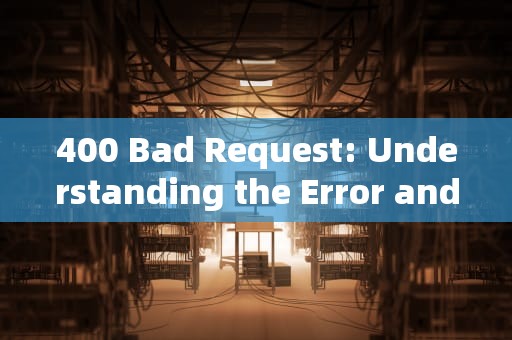In the vast realm of internet browsing and web development, encountering a "400 Bad Request" error can be both frustrating and perplexing. This HTTP status code indicates that the server cannot understand the request due to invalid syntax. While it may seem like a minor inconvenience to some, understanding what causes this error and how to resolve it is crucial for maintaining a smooth user experience on your website. In this article, we will delve into the intricacies of the 400 Bad Request error, explore its common causes, and provide practical solutions to mitigate it.

What is a 400 Bad Request Error?
A 400 Bad Request error is an HTTP response status code that indicates there was a problem with the structure or content of the request sent by the client (such as a web browser) to the server. Unlike other errors that might stem from server-side issues, a 400 error points directly to a problem with the request itself. This could be due to incorrect syntax, missing parameters, or malformed data.
Common Causes of 400 Bad Request Errors
1、Malformed URL: One of the most frequent causes of a 400 error is a malformed URL. This includes typos, special characters that are not properly encoded, or incorrect use of query parameters. For example, using spaces instead of percent-encoding can lead to such errors.
2、Invalid Headers: HTTP headers must adhere to specific formatting rules. If a header is missing, improperly formatted, or contains unsupported values, it can trigger a 400 error.
3、Request Body Issues: When making POST or PUT requests, the data within the request body must be correctly formatted according to the expected MIME type. Incorrect JSON, XML, or form data can result in a 400 error.
4、Missing or Invalid Data: Web applications often require certain data fields to be present and valid. Omitting required fields or submitting data that doesn't meet validation criteria can lead to a 400 response.
5、Cross-Site Request Forgery (CSRF) Token Expiration: Some applications implement CSRF protection by including tokens in forms. If these tokens expire or are incorrect, they can cause a 400 error when submitting the form.
6、Server-Side Parsing Errors: Although less common, server misconfigurations or bugs in the handling of requests can also result in a 400 response being sent back to the client.
Diagnosing and Fixing 400 Bad Request Errors
1、Check the URL: Ensure that the URL is correctly formed, without any typographical errors. Use URL encoders for special characters and verify that all necessary query parameters are included and properly formatted.
2、Validate Headers: Carefully inspect the HTTP headers being sent with your request. Make sure they conform to the expected format and contain valid values. Tools like Postman or browser developer tools can help in examining and debugging headers.
3、Review Request Body: For POST, PUT, or PATCH requests, double-check the structure and content of the request body. Ensure that JSON objects are correctly formatted, form data is appropriately encoded, and all required fields are present and valid.
4、Verify Data Requirements: If the error occurs during form submission or API calls, review the documentation to ensure all mandatory fields are provided and meet the specified criteria. Pay attention to data types, length restrictions, and allowed characters.
5、Refresh CSRF Tokens: If your application uses CSRF tokens, make sure they are current and valid. Often, simply reloading the page or generating a new token can resolve issues related to expired or incorrect tokens.
6、Consult Server Logs: Server logs can provide valuable insights into why a 400 error was returned. Look for detailed error messages or stack traces that might indicate what went wrong on the server side.
7、Test with Different Tools: Sometimes, the issue might be specific to the tool or library you are using to make requests. Try testing your request with different clients (e.g., curl, Postman, or a different browser) to isolate the problem.
8、Update Dependencies: Outdated libraries or frameworks can sometimes be the root cause of unexpected behavior, including generating incorrect requests. Ensure that your development environment and all associated packages are up-to-date.
9、Consult Documentation and Community: If you're integrating with a third-party API or service, their documentation or support community might have encountered similar issues and provide guidance on resolving them.
10、Implement Robust Error Handling: On the server side, implementing comprehensive error handling can help identify and respond to bad requests more gracefully. This includes logging detailed error information and providing meaningful feedback to clients about what went wrong.
Conclusion
While encountering a 400 Bad Request error can initially seem daunting, it serves as a vital signal that something needs attention in the way requests are constructed or handled. By systematically checking and correcting potential issues, from URL formation to request body content and server configurations, understanding and addressing these errors can significantly enhance the reliability and user experience of your web applications. Remember, thorough testing, meticulous attention to detail, and continuous learning are key to minimizing such occurrences and ensuring seamless communication between clients and servers.
随着互联网的普及和信息技术的飞速发展台湾vps云服务器邮件,电子邮件已经成为企业和个人日常沟通的重要工具。然而,传统的邮件服务在安全性、稳定性和可扩展性方面存在一定的局限性。为台湾vps云服务器邮件了满足用户对高效、安全、稳定的邮件服务的需求,台湾VPS云服务器邮件服务应运而生。本文将对台湾VPS云服务器邮件服务进行详细介绍,分析其优势和应用案例,并为用户提供如何选择合适的台湾VPS云服务器邮件服务的参考建议。

工作时间:8:00-18:00
电子邮件
1968656499@qq.com
扫码二维码
获取最新动态
